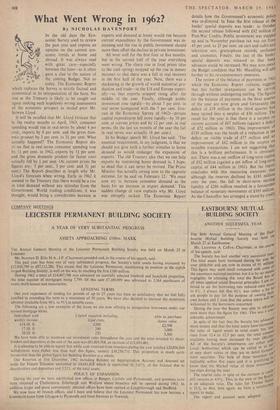What Went Wrong in 1962?
By NICHOLAS DAVENPORT
IN the old days the Eco- nomic Survey used to review the past year and express an
a opinion on the current eco-
o nomic trends at home and
abroad. It was always read
0 • with great care—especially 0 between the lines—as it often
gave a clue to the nature of the coming Budget. Not so today. The Economic Report which replaces the Survey is strictly factual and economical in its interpretation of the facts. No one at the Treasury is likely to be caught out again making such hopelessly wrong assessments of the economic prospect as misled poor Mr. Selwyn Lloyd.
It will be recalled that Mr. Lloyd forecast that in the twelve months to April, 1963, consumer spending would rise in real terms by about 4 per cent., exports by 8 per cent. and the gross dom- estic product by 3 per cent. to 34 per cent. What actually happend? The Economic Report dis- cicses that in real terms consumer spending rose by I+ per cent. in 1962, exports by 14 per cent. and the gross domestic product (at factor cost) actually fell by 4 per cent. (At current prices the figures are: 5 per cent., 3 per cent. and 34 per cent.) The Report describes at length why Mr. Lloyd's forecasts when wrong. Early in 1962 it seemed to the Treasury that there would be a rise in total demand without any stimulus from the Government. World trading conditions, it was thought, would bring a considerable increase in exports and demand at home would rise because current expenditure by the.Government was in- creasing and the rise in public investment should more than offset the decline in private investment.
All went well for the first four or five months, but in the second half of the year everything went wrong. The sharp rise in food prices (due to the cold spring) mopped up the rise in money incomes so that there was a fall in real incomes in the first half of the year. Next, there was a slackening in the growth of world industrial pro- duction and trade—in the US and Europe especi- ally—so that exports stopped rising after the middle of the year. Finally, although public investment rose rapidly—by about 7 per cent. in real terms (compared with the 5 per cent. fore- cast in the Economic Survey of 1962)—private capital expenditures fell more rapidly—by 10 per cent. at current prices and by 12 per cent. in real terms. (In the last six months of the year the fall in real terms was actually 18 per cent.) In his Budget speech Mr. Lloyd has said: 'The essential requirement, in my judgment, is that we should not give such a further stimulus to home demand as would endanger the expansion of exports.' The old Treasury idea that we can help exports by restraining home demand is, I hope, so dead that it can never be revived. The Prime Minister has actually swung over to the opposite extreme, for he said on February 12: 'We must now try to increase consumer demand as the basis for an increase in export demand.' This sudden change of view explains why Mr. Lloyd was abruptly sacked. The Economic Report
details how the Government's economic policy was re-directed. In June the first release of the banks' special deposits was made: in October the second release followed with £42 million of Post-War Credits. Public investment was stepped up and in November purchase tax was cut from 45 per cent. to 25 per cent. on cars and radio and television sets, gramophone records, perfumes and cosmetics. Finally. the last of the banks' special deposits was released so that bank advances could be increased. We may now await the Budget confident that Mr. Maudling will add further to his re-expansionary measures. The review of the balance of payments in 1962 which the Economic Report contains suggests that this further re-expansion can be carried through without endangering sterling. The figures for the balance of payments in the final quarter of the year are now given and fortunately the deficit of £19 million in the third quarter had been turned into a surplus of £36 million. The result for the year is that there is a surplus on current account of £67 millions (against a deficit of £72 million in 1961). This improvement of £139 million was the result of a reduction in the deficit on visible trade of £77 million and an improvement of £62 million in the surplus on invisible transactions. I am not suggesting that this is a brilliant performance. It is obviously not. There was a net outflow of long-term capital of £92 million (against a net inflow of long-term capital of £44 million in 1961). But the report concludes with this reassuring statement that although the reserves declined by £183 million over the year, the fall in short-term sterling liability of £286 million resulted in a favourable balance of monetary movements of £103 million: As the Chancellor has arranged a stand-by credit
with the IMF of $1,000 million—and we have further IMF facilities of about $1,500 million— Mr. Maudling should be bold next week in his further attempt to re-expand the domestic economy and put to work more of the mass of unemployed who are obviously becoming in- creasingly restive.















































 Previous page
Previous page